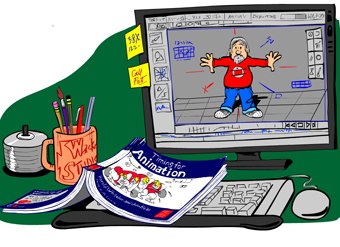The venerable Timing for Animation primer has been updated for the digital age, and Tom Sito discusses the significance.
Timing is everything -- particularly in animation. As John Lasseter points out in the Foreward of Timing for Animationby Harold Whitaker and John Halas (Focal Press, second edition, updated by Tom Sito),"With computer technology, I quickly learned more about animation and the movement of objects than ever before. It was then that I realized that the lessons in this book of animation are so important."
And the lessons are now all the more relevant, thanks to Sito, who will receive the June Foray Award at ASIFA-Hollywood's 37th annual Annie Awards (Feb. 6, 2010 at UCLA's Royce Hall).
Bill Desowitz:How did you become involved in updating this second edition?
Tom Sito:
Focal Press contacted me about wanting to do an update and it's one of the famous how to books but the issue was, technologically speaking, it's in the '60s. It talked about a lot of technique that weren't relevant to a modern digital workforce, so I found the idea intriguing about working with existing material and sort of adding to it without losing what everybody likes about the original.
BD: And so you worked in motion and performance capture and previs and various new hardware and software.
TS: Yeah, basically, storyboarding in 3D, the newer 2D digital packages like Flash and Toon Boom, creating animation for the web. Also, the realities of the global market, because when Halas and Whitaker were working, animation companies didn't send stuff out. Now we have this global production house where you're going to be working with people who may not even speak your language. So how do you time shows and direct shows using a workforce you may not meet in person.
I worked with a Taipei studio on a short film and I basically completed it basically from my kitchen back in Los Angeles. I would sit at my laptop and download footage from the FTP site and send them notes and once in a while have a Skype conference. And it struck me how I was directing this crew of 50 from my kitchen.
And when I did theCar Talkseries, we had our musicians in Texas, our production facility in Vancouver, board artists here and soundtrack and post back in New York.
Again, Halas and Whitaker's book is a great primer for learning the art of timing and character animation, so, to me, I was just augmenting what already existed in the text and bringing it up to modern practices.
BD: Timing is still an important issue. Are the fundamentals being adhered to?
TS: Well, it's a concern that a lot of artists of my generation have, which is that certain skill sets in traditional timing and acting and performance were drummed into us by the Golden Age generation. And the problem we face is that there is such an emphasis on learning the technology. If you learn to click on the right file folders and drag down the right menus, that's animation. And what we're saying is that it's more than that. Granted, the present generation has a real challenge ahead of them, which is that they have to learn all the analytical aspects of mastering the technology and on top of that they have to learn what we know about the intuitive and the sensual about how to make timing work.
You know, Art Babbitt used to say, "If you can't feel it, it doesn't work." And trying to get that same kind of tactile feel into your timing takes a certain amount of development in your education as an artist.
BD:What about this year's excellent crop of films? How would you judge their timing?
TS: I think there's certainly some very handsome work this year and some great technique out there. Of course, the performances in The Princess and the Frogwere great. There's some wonderful stuff inIce Age 3andUp. I think what's interesting is hopefully the re-emergence of the animation actor because there was a period in the '90s renaissance when you had lead animators running their characters completely through a performance, and really acting as the animation actor. And with some of the 3D, because the animators were responsible for [multiple characters in the frame], it could've been the case that some of the animator's performance was diluted because he had to think about the three different personalities. And when I look at this year, we're getting back toward an overall performance on a single character: Eric Goldberg doing the alligator and the little boy inUp. Those were really nice performances.
Again, it's that challenge of my boomer generation to make sure that all the things that we were taught by the Golden Age guys really do get passed on to the next generation. And timing for animation is part of that process
Bill Desowitz is senior editor of AWN & VFXWorld.









